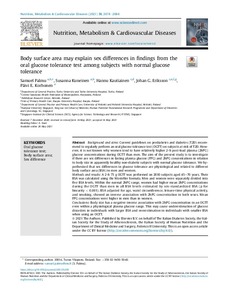Body surface area may explain sex differences in findings from the oral glucose tolerance test among subjects with normal glucose tolerance
Palmu Samuel; Kuneinen Susanna; Kautiainen Hannu; Eriksson Johan G.; Korhonen Päivi E.
https://urn.fi/URN:NBN:fi-fe2021102752635
Tiivistelmä
Abstract
Background and aims
Current guidelines on prediabetes and diabetes (T2D) recommend to regularly perform an oral glucose tolerance test (OGTT) on subjects at risk of T2D. However, it is not known why women tend to have relatively higher 2-h post-load plasma (2hPG) glucose concentrations during OGTT than men. The aim of the present study is to investigate if there are sex differences in fasting plasma glucose (FPG) and 2hPG concentrations in relation to body size in apparently healthy non-diabetic subjects with normal glucose tolerance. We hypothesized that sex differences in glucose tolerance are physiological and related to different body surface area (BSA) in men and women.
Methods and results
A 2-h 75 g OGTT was performed on 2010 subjects aged 45–70 years. Their BSA was calculated using the Mosteller formula. Men and women were separately divided into five BSA levels. Within the normal 2hPG range, women had higher mean 2hPG concentrations during the OGTT than men in all BSA levels estimated by sex-standardized BSA (p for linearity < 0.001). BSA adjusted for age, waist circumference, leisure-time physical activity, and smoking, showed an inverse association with 2hPG concentration in both sexes. Mean FPG concentrations were higher in men than in women.
Conclusions
Body size has a negative inverse association with 2hPG concentration in an OGTT even within a physiological plasma glucose range. This may cause underestimation of glucose disorders in individuals with larger BSA and overestimation in individuals with smaller BSA when using an OGTT.
Kokoelmat
- Rinnakkaistallenteet [27094]
